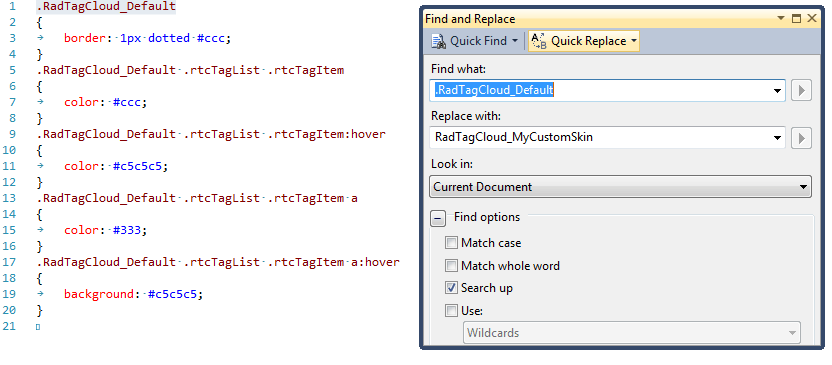Creating a Custom Skin
Each of the controls included in the Telerik® UI for ASP.NET AJAX suite is styled with two CSS files that are loaded in a certain order. The first one - ControlName.css (also called base stylesheet), contains CSS properties and values that are common for all skins, i.e it is layout-specific, not skin-specific. These are CSS float, padding, margin, font-size, font-family, etc. In the general case, when creating a custom skin for a control this file should not be edited, unless the custom skin needs different sizes, padding or margins.
The second file represents the actual skin of the control, and its name consists of the control name plus the skin name, i.e - TagCloud.Default.css. Upon creating a custom skin for the control, one should edit that particular file, as it contains skin-specific CSS properties, and references to images, colors, borders and backgrounds.
Creating a Custom Skin for RadTagCloud for ASP.NET AJAX from an Existing One
In order to explain better the CSS classes of RadTagCloud, we will use both TagCloud.css and TagCloud.SkinName.css as external resources. We will modify an existing skin of RadTagCloud. Follow these steps to register an external skin for RadTagCloud for ASP.NET AJAX before editing any CSS:
In your project, create a new directory named Skins
In the skins folder create a new directory MyCustomSkin.
Go to ~/[TelerikControlsInstallationFolder]/Skins and copy TagCloud.css in your Skins folder
Go to ~/[TelerikControlsInstallationFolder]/Skins/Default and copy TagCloud.Default.css in your Skins folder.
Rename TagCloud.Default.css to TagCloud.MyCustomSkin.css and the folder Default to MyCustomSkin.
When you are finished you should have: Skins/TagCloud.css, Skins/MyCustomSkin/ and TagCloud.MyCustomSkin.
-
In order to support multiple skins of RadTagCloud on a single page, the wrapping skin-specific class is coined by the name of the control, RadTagCloud plus underscore ("_") plus SkinName, i.e . RadTagCloud _Default, so in order to create a custom skin out of the Default skin, we should rename all occurrences of "Default" in TagCloud.MyCustomSkin.css to "MyCustomSkin" as shown below:

-
Put a new server declaration of RadTagCloud on your page, and set Skin="MyCustomSkin", EnableEmbeddedSkins="false" and EnableEmbeddedBasestylesheet="false":
ASP.NET
<telerik:RadTagCloud RenderMode="Lightweight" Id="RadTagCloud1" runat="server" Skin="MyCustomSkin" EnableEmbeddedSkins="false" EnableEmbeddedBasestylesheet="false"> </telerik:RadTagCloud> -
Register TagCloud.css and TagCloud.MyCustomSkin.css in the
... section of your web page. In order to have the CSS applied correctly, the base stylesheet should come first in the DOM:Important: Make sure the path to the files is correct, otherwise the skin will not apply.HTML
<link rel="stylesheet" type="text/css" href="Skins/TagCloud.css"></link> <link rel="stylesheet" type="text/css" href="Skins/MyCustomSkin/TagCloud.MyCustomSkin.css"> </link> Reload the page, and if the steps 1-9 have been followed correctly, you will see a RadTagCloud running a custom MyCustomSkin skin set as an external resource.